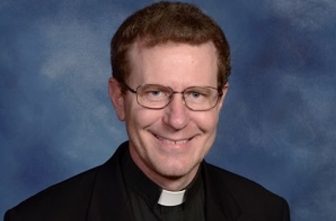
In late December 1860, Bishop Thomas Grace received an extremely concerning letter at his residence in St. Paul.
It had come from St. Boniface (now better known as Winnipeg), the city-see of the diocese to the north, and it relayed the injuries of one of Bishop Grace’s priests, Father Joseph Goiffon. Father Goiffon was pastor of Pembina along the Red River at the northern edges of Minnesota Territory. He had just traveled over 700 miles on horseback as part of an ox-cart train from Pembina to St. Paul and back again over the course of two months.
Anxious to get back to his parish by the end of October, Father Goiffon had ridden out ahead of the party on his horse without warm-weather provisions and had been trapped in a blizzard a few miles outside of Pembina. While he prayed to be rescued, he waited for nearly five days in the snow, surviving by eating parts of his horse. When a cart train finally caught up to him, he was delirious and facing severe frostbite, so they put him on a dogsled and pulled him all the way to the bishop in St. Boniface for medical attention. There, he had his right leg amputated below the knee along with part of his left foot.
The letter told only half of the story. After recovering from surgery for about a week, Father Goiffon’s condition took a turn for the worse, and one of his arteries started hemorrhaging. Doctors could find no way to stop the bleeding, so he was given last rites and expected to die within the hour. Meanwhile, another crisis was just beginning in the bishop’s residence. A fire broke out, rapidly spreading through the house and to the nearby cathedral. Father Goiffon was saved from the flames by being carried outside into the sub-zero temperatures on his mattress. The cathedral was a complete loss. Father Goiffon, however, survived. The cold had caused his artery to clot, and he managed to recover and later returned to his parish in Pembina.
After receiving the news, Bishop Grace decided that it was time for him to visit the northern portion of his diocese. Although the Diocese of St. Paul had been established in 1849, neither Bishop Grace nor his predecessor had ever visited the parishes of the far north. Bishop Grace set out from St. Paul, with his companions, on Aug. 1, 1861. He finally reached Pembina and its sister parish in St. Joseph to find Father Goiffon working diligently to minister to his parishioners, most of whom were Métis (born from fur-trading French or Scottish fathers and Native American mothers). Bishop Grace confirmed 53 souls before returning to St. Paul.
Pembina and St. Joseph remained the most distant outpost of the Diocese of St. Paul until 1879, but it might have gone a different way. When Minnesota became a territory in 1849, St. Paul had only recently become a city. Pembina had been settled for more than 50 years by French Canadian fur traders and had a log chapel built by missionaries. However, it was also hard to reach from elsewhere in the state and less than 100 miles from the city-see of St. Boniface in Canada, so St. Paul became the bishop’s home. Eventually, railroads made trips to Pembina and beyond far faster and safer, but for a few decades, the bishop of St. Paul continued to lead a truly frontier Church that extended all the way to the Missouri River.
Luiken is a Catholic and a historian with a doctorate from the University of Minnesota. She loves exploring and sharing the hidden histories that touch our lives every day.




